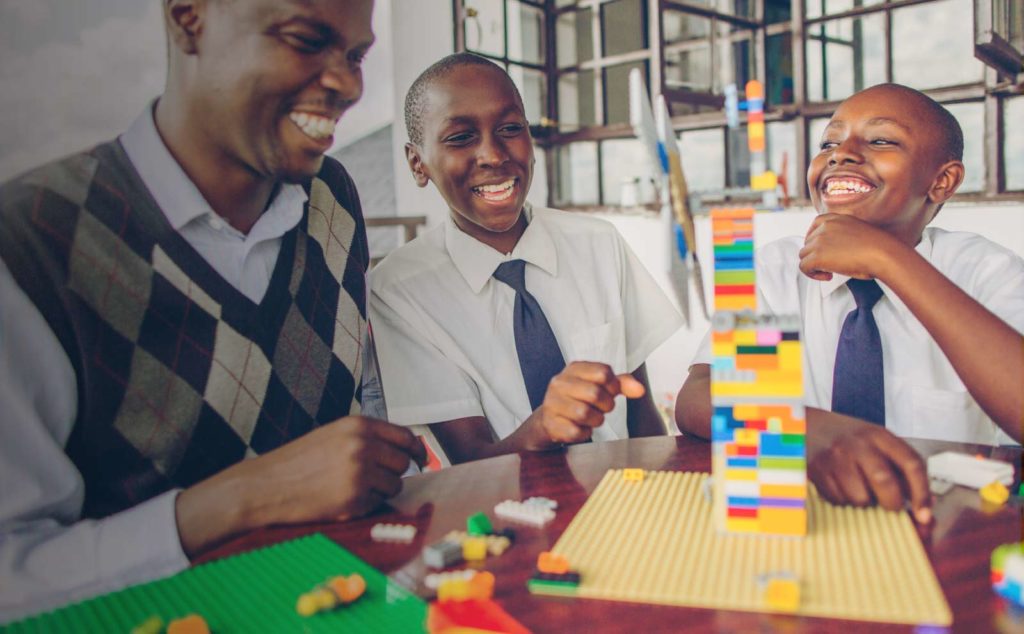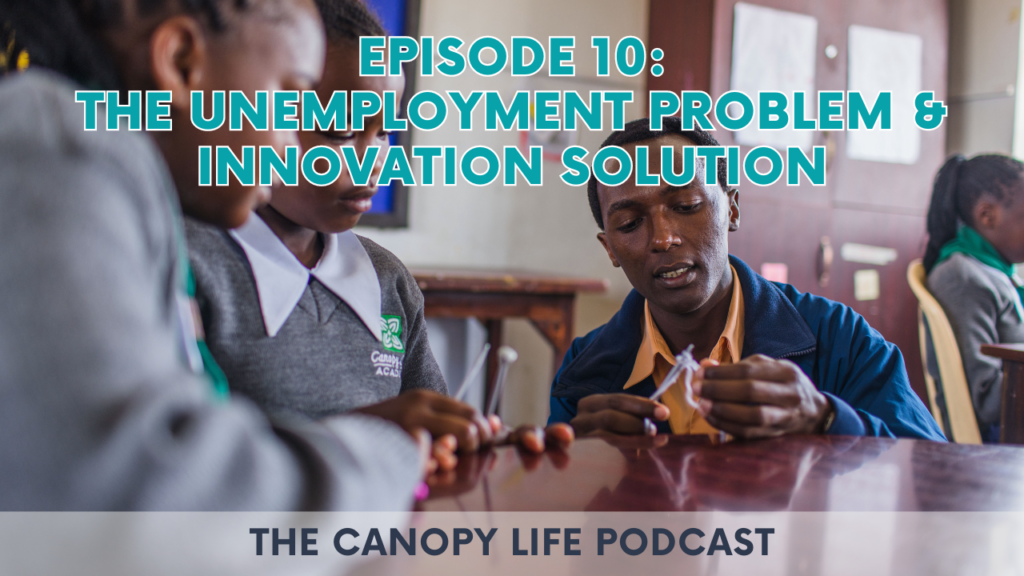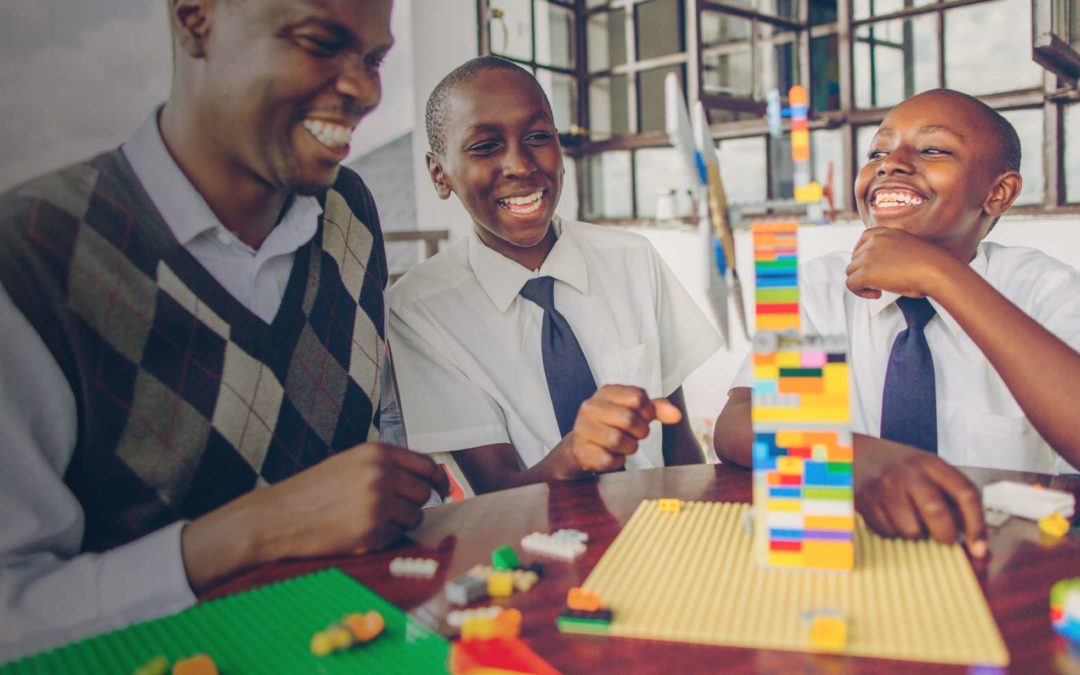In episode 10 of the Canopy Life podcast, Christi Gordy (Canopy Life founder) and Evan Chasteen (show host) discuss the unemployment rate and how Canopy Life is cultivating Godly innovators to create jobs in rural Kenya.
The goal of our innovation program at Canopy Life is to give our students the skills they need to cultivate an idea to market, grow a healthy business, and lead with integrity.
We exist to help kids overcome the odds– like the unemployment rate in Kenya – to create jobs for themselves that don’t just serve their own needs of income but that provide jobs for others in their communities.
What does the unemployment rate mean for the children growing up in rural Kenya?
Basically, it means there are no jobs waiting for these kids when they are finished with school.
Imagine what it’s like for these kids who are already overcoming the odds of making it to high school and college, and then there are no jobs available.
There’s only about a 50% chance kids in rural Kenya will go to high school. An even smaller percentage make it to college. There is a greater chance of finding a job if they have a degree, but the chances are still low.
It’s important to note, that unlike how I think that would affect Americans, I do think that Kenyans have an unbelievable, and maybe even an unrealistic level of hope – hope, that if they work hard, they can achieve their dreams. There’s not this pervasive hopelessness in kids, but at some point, there is this wake-up call that there’s not a job waiting, and they’re going to have to hustle and struggle.
Christi Gordy, Episode 10
If you asked someone in a rural community what challenges they face for finding employment, most likely they would say it was their education, not the unemployment rate in Kenya.
Has the unemployment rate been an issue for a long time?
According to the World Factbook, data collected by the C.I.A., the unemployment rate has been as high as 40% in the early 2000s. It seems to have been a problem for a long time.
Although this unemployment rate is still an issue, progress has been made since 2000. Kenya has a growing entrepreneurial middle class. This growth is steady. Based on information from the World Factbook, economic development has been impaired by weak government and corruption.
What economic progress has been made since 2000?
The Kenyatta administration has taken strides to improve infrastructures such as improving major highways and building new railway systems, but there’s definitely a need for more infrastructure in order to create more jobs. It’s a slow process.
There’s currently a vision and movement to grow Kenya’s Silicon Savannah – the digital industry and startup community. There’s been a nod from the government saying they are going to provide funding for a separate technological city outside of Nairobi for these industries to grow. It’s a part of Kenya’s vision for 2030. On the grassroots level, these industries are thriving.

What does innovation mean for Canopy Life?
Webster defines an innovator as someone who is making a change by introducing something new. For us, it’s the same. Our mission is to help kids become Godly innovators. We have this saying at Canopy Life: “Real leaders serve others with their power, resources, and ideas.”
To be a Godly innovator means solving problems with people in mind, not just solving them to make a ton of money.
So, practically, what does being a Godly innovator look like?
At Canopy Life, we’ve been developing a curriculum for innovation. At the core of this curriculum is Design Thinking.
We lean heavily into the work done at Stanford Design School. They call it “human-centered” design. It’s the idea of solving problems with people in mind.
The Design Thinking process is cyclical. You begin by observing and getting to know the person or group you are designing for, known as empathy, and continue by working through this process as many times as needed to ensure you solve the right problem for the right person. These 6 stages are:
- Empathy – Trying to understand the problem from the “user’s” perspective (the person you are helping)
- Define – Defining the problem you are trying to solve
- Ideate – Brainstorming
- Prototype – Creating an example of what you think the solution is as quickly and inexpensively as possible. Think scotch tape and construction paper. If it looks too polished, you may inhibit feedback! People may be afraid to hurt your feelings if the prototype looks like you’re deeply invested in the design.
- Test – Take it the person or group you are designing for and get their feedback
- Redefine/Reiterate – Assess to see if you are solving the right problem for the right person
If you’re curious about Design Thinking, check out this awesome resource created by the Stanford D.school. In our next podcast, we will be interviewing Sara Musgrove for a more in-depth look at how you can use the six stages of design thinking to find innovative solutions in your world.
The Quest
With this curriculum, our students are learning hard and soft skills (everything from how to use a hammer to budgeting to using Google Suite) in order to grow into the innovators we hope they will become. Our Innovation Director, Davis, has developed a curriculum where our students can put these skills into practice.
We call it, “The Quest.” Think, Shark Tank, but for students.
Our students create a hypothetical business that they believe solves a problem. They have to complete a business plan, create a logo, a website, an elevator pitch, a budget (including taxes and wages for their employees). They even have to suggest sources of funding to get their business started! Then, they present it to the Canopy Life staff and teachers.
We’ve seen our students come up with ideas such as biodegradable water balloons and a fashion line from recycled materials. Be sure to check out Episode 10 to hear the stories behind their ideas.
How will Canopy Life students create jobs in Kenya?
The hope is that by the time these students are seniors in high school, we are legitimately seeking funding for some of their ideas.
Kenya is on the rise. Part of the gap Canopy Life is filling is the Innovation gap. There is a lot of innovation in the capital city, but it will be decades before this innovation reaches the rural villages if someone doesn’t stand in the gap. Canopy Life is going to be the place where rural leaders can learn to create industries that their communities can benefit from.
Christi Gordy, founder

